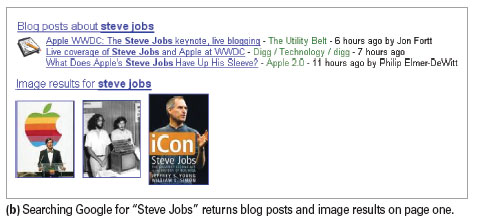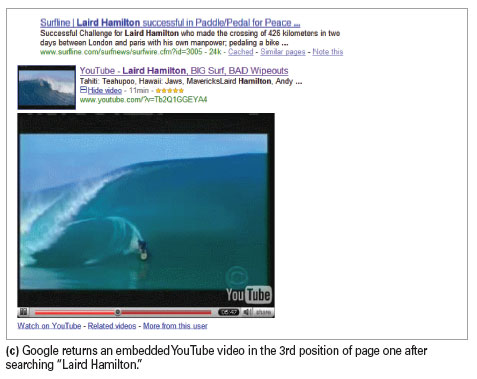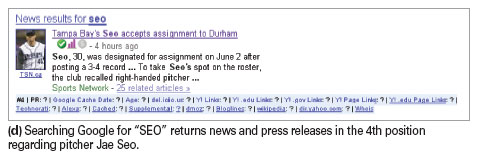Google's Universal Search

by Paul J. Bruemmer and John Faris
Google wants to help you find the best answers, even if you don't know where to look. So it folded all its verticals into Web results as an assist. Listen up, search marketers - it's no longer an option to include optimized images, videos, news, local maps or blogs in your SEM strategy; it's a requirement. Google's launch of Universal Search has opened up the possibility for even more tactics to be applied and requires a new outlook on your SEO strategy.
Search engine rankings boil down to three things: links, content, and relevancy. Sounds simple, right? Not so much. It gets complicated at the tactical level because of the infinite ways to create relevant content and earn relevant links. The secret to website optimization is finding the most effective tactics and developing a process to implement them in a scalable way.
With Universal Search, the information (content) readily available to Google users has been vastly diversified to include alternative media such as news, video, images, blogs and other verticals Google has in its back pocket. For search marketers, the strategy stays the same: develop content and get links. The only difference is that now, the list of tactics to choose from has significantly increased (as if it wasn't long enough already).
What is Universal Search? Universal Search combines all of Google's various vertical databases into one index to serve a single set of Web search results. Here's a rundown on some of the most popular verticals that Universal Search will include.
1. Google Blog Search: Let's hope you all have a corporate blog. This important Web 2.0 tool has revolutionized the way companies interact with customers and the media. Not only that, you need a blog for reputation management. Your team will love expressing their opinions on a regular basis. Don't forget to tag (digg, del.icio.us, reddit, stumbleupon, etc.), and then submit to broaden your reach for all target queries on Google.
2. Google Maps: Local search is hot, and your businesses can benefit from a local presence. Mobile search is also gaining momentum, and I don't need to emphasize the growing importance of the small screen. Go to the Google Maps Local Business Center for a free basic and/or paid listing.
3. Google Video: This is another hot area that should be considered. The cost of creating video content can vary, depending on your pocketbook. Just remember to use keyword- rich file names that accurately describe your video. And don't forget to use a video site map. You'll need a Web page from where to launch your video - optimize the content using traditional SEO tactics. Create page titles, description tags and text (transcription, captions, commentary, etc.) that are keyword friendly. Submit to Google Video, YouTube and other video search engines and portals like blinkx and Metacafe. You will also want to promote your best videos within the blogosphere and on relevant social media sites.
Interesting things are taking place on Google's search network on the video front. For example, a search for "Steve Jobs video" on AOL (powered by Google) returns video results but not from YouTube. The YouTube video in position three is not converted into a dynamic video (as it is on a standard Google search) and AOL video results are force-fed to the top. It's probably a good time to start thinking about syndicating your content on AOL video.
4. Google Image Search: Google finally acknowledged the old adage that "a picture is worth a thousand words." Now, customers can find you via these images with ease. Unlike most other Universal Search results, images (and blog search results) are not being integrated into the top ten results, but are being served to the top (or bottom) of search result pages. This positioning garners the attention of plenty of eyeballs, so you'll want to optimize your images with descriptive ALT tags that make use of popular keywords. Make sure you employ descriptive keywords when creating file names as well. As with video, search engines can't interpret the meaning of an image - yet. Consequently, make sure you employ standard on-page text optimization techniques in addition to image optimization.
5. Google News: Using press releases to enhance SEO listings is now a standard practice. Keep your releases newsworthy and the information will be displayed and indexed as news. News is informative when you announce training seminars and local conferences; it borders on boring when you announce a new client account.
Universal Search Examples
With the launch of Google Universal Search, a search for "Steve Jobs" provides news results in the fourth organic position (a), with blog posts and image results included on page one of search engine results (b).


A search for big-wave surfer Laird Hamilton provides a YouTube video in the third organic position that you can play without leaving the search result page (c).
 It's important to note that the page hosting the video on YouTube does not have a significant amount of inbound links, and a scan of the page shows only a few mentions of Laird Hamilton. However, this video has been viewed over 180,000 times, has a fivestar rating and has been tagged on social media sites like StumbleUpon. This indicates that each vertical, including video has its own set of ranking variables that may be quite different from those used for ranking the standard website. It also means that developing, syndicating and promoting creative content just got much more important.
It's important to note that the page hosting the video on YouTube does not have a significant amount of inbound links, and a scan of the page shows only a few mentions of Laird Hamilton. However, this video has been viewed over 180,000 times, has a fivestar rating and has been tagged on social media sites like StumbleUpon. This indicates that each vertical, including video has its own set of ranking variables that may be quite different from those used for ranking the standard website. It also means that developing, syndicating and promoting creative content just got much more important.
News and press releases have also been given a promotion in the rankings. For example, a search for the term "SEO" returns news results in the fourth organic position regarding Tampa Bay pitcher Jae Seo accepting assignment to Triple-A Durham, four hours ago at the time of writing this article (d).
 The first steps in launching Universal Search took place on May 16, 2007, but the full extent of its power will not be seen until November and beyond. As Google's new algorithm integrates additional types of content into its Web search results, users will witness a more comprehensive search experience providing a wide array of information on the topic of their query.
The first steps in launching Universal Search took place on May 16, 2007, but the full extent of its power will not be seen until November and beyond. As Google's new algorithm integrates additional types of content into its Web search results, users will witness a more comprehensive search experience providing a wide array of information on the topic of their query.
Impact on Search Marketers
Just like many 15th century Europeans believed that the earth was flat, many of today's search marketers are stuck in a twodimensional mindset. Of course, the earth is round and with Universal Search, search marketers can no longer rely on text-based SEO and Pay-Per-Click (PPC) advertising alone. It's time to buy your creative team a round of beers and start thinking feeds, widgets, and social media.
Feeds include:
- Google Local Business (Google Maps) when applicable
- RSS and press release syndication (Google News)
- YouTube video syndication (YouTube)
- Google Base (XML product feed) when applicable
- Google Books (XML book feed) when applicable
Widgets include:
- Viral desktop applications
- Web-based widgets for social media sites and blogs
Social Media includes:
- Blogging
- Blog monitoring
- Blogosphere public relations
- Online brand/crisis management
- Content syndication
- Link baiting
- Wikis, forums, and chat
- Viral ad campaigns
Measurement and ROI
Universal Search results in two mandates: 1) the array of search marketing options is no longer optional, but obligatory and, 2) measurement is more important then ever before.
Search services (when appropriate) now include:
- Paid Search (on more than Google)
- Pay-Per-Call (national services companies)
- Google and Yahoo! Local Business (chains)
- Google Base (product SKUs)
- Google Books (product SKUs)
- Shopping optimization feeds
- Shopping comparison engines
- Paid directories (major and verticals)
- Extensive and redundant keyword research
- Natural search diagnostic site audit
- Page editing and optimization
- Serious recurring inbound link-building strategy and tactics
- Social media optimization
- Brand reputation management
Measurement factors include:
- Integration of natural search on paid listing shelf-space
- Keyword inventory and traffic analysis
- Offline and online (paid and natural) competitor analysis
- Natural search cost-benefit analysis
As Google's new algorithm builds momentum we will begin to see more Universal Search influence on search result pages. This process will take more than six months, it won't happen overnight.
We believe Universal Search is designed primarily for two reasons: Deeper content for users and better ad targeting.
Google wants you to use its verticals such as Image, Video and News, among others. What better way than to force-feed that data into primary organic search results? It's no coincidence Google is beginning to serve video and image PPC (and CPM) ads on its content network. Integrating images and videos into the natural results will make it easier for Google to start serving these ad types on its search engine result pages and search network (AOL, et. al.). And, as usual, Google wants to create more ad space. What better way than to promote its vertical space and unfold new shelf-space within these verticals?
So, it goes without saying that when Google changes things up, we all must adapt or get left behind. Dig deeper in your SEO toolbox - the standards have changed. Including press releases, video, blogs, news, images and maps are just some of the verticals Google is giving precedence. Search results are changing and those that expand the reach of their website's content will be those that prosper in this new era of search.
About The Authors:
Paul J. Bruemmer has provided search engine marketing expertise and in-house consulting services to prominent American businesses since 1995. As Director of Search Marketing at Red Door Interactive, he is responsible for the strategic implementation of search engine marketing activities within Red Door's Internet Presence Management (IPM) services.
John Faris is a Search Analyst at Red Door Interactive. Faris' primary role is to create initial search engine marketing (SEM) recommendations and execute strategic recurring SEM for Red Door's Internet Presence Management clients. He also develops process and strategy for Red Door's Search Marketing department.









